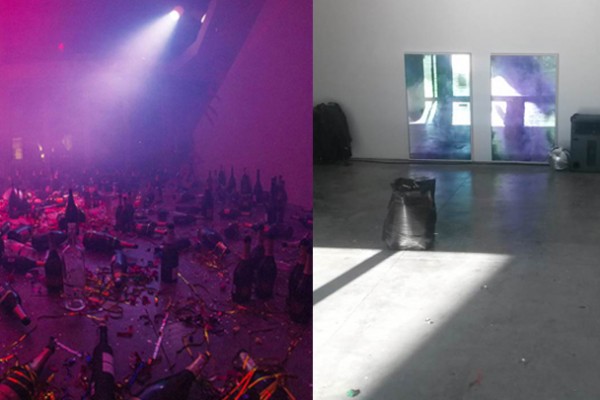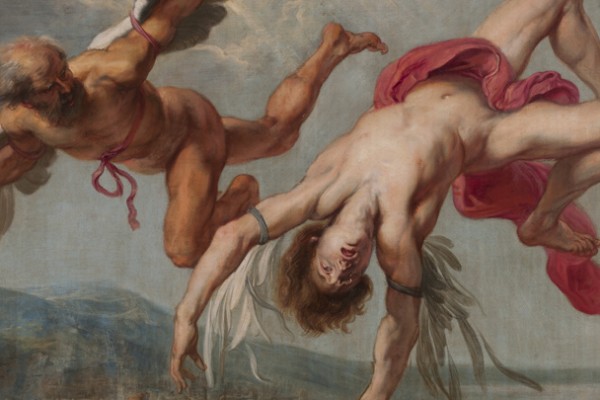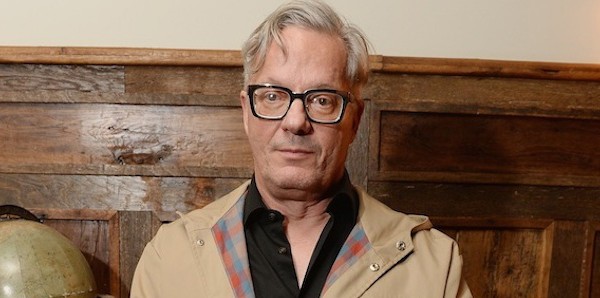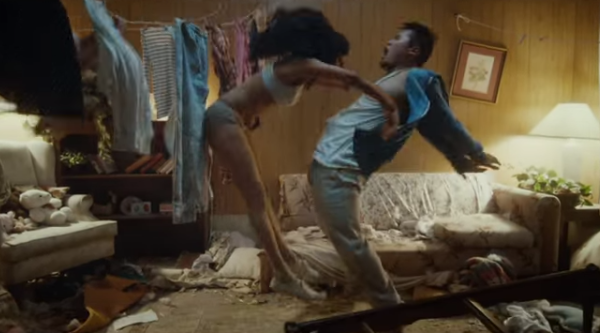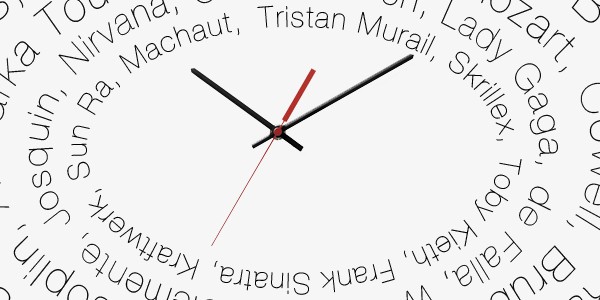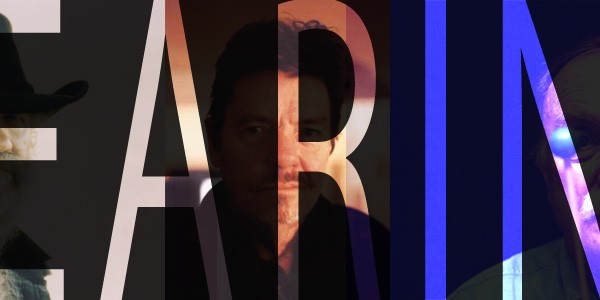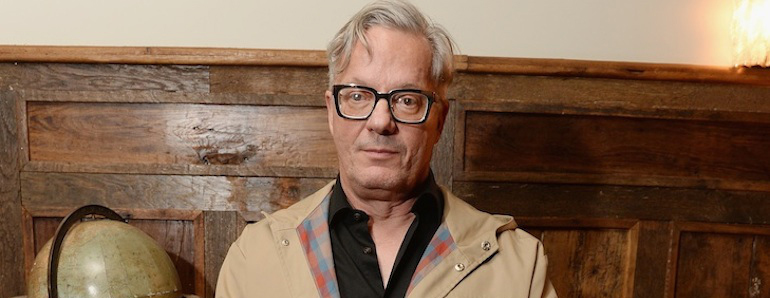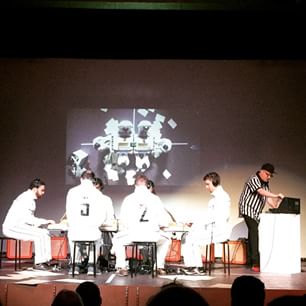I recently visited the Mark Mothersbaugh Myopia retrospective at the Museum of Contemporary Art (MCA) Denver, which is on exhibit until April this year. I also attended the artist’s 6-sided keyboard concert and exhibition talkback last month. But despite my cursory understanding of Mothersbaugh as a composer, pop star, and wide-ranging visual artist, I wasn’t quite prepared for the sheer deluge of material I encountered.
Diversity + Quantity = Claustrophobia
After listening to his suite of carnivalesque compositions for 6-sided keyboard, watching early Devo performances and considering the relevance of his alter ego Booji Boy, rectifying both the similarity and individual appropriateness of his compositional work for productions like Pee Wee’s Playhouse, four Wes Anderson films, and the Lego Movie, questioning why his bird-call and salvaged pipe organ orchestrions were playing little midi tunes, laughing at the cute symmetry of two rear-ends of two Scion iQs welded together and placed in a room full of “vintage” photographs depicting grotesque mirror-inverted faces, and winding my way through a little community of ceramic, paint-dolloped trolls frolicking on patches of artificial grass… I wasn’t prepared for what was next. The largest gallery on the upper-floor of the MCA currently showcases the bulk of Mothersbaugh’s output: something like 30,000 postcard-size works of illustration, collage, photography, and text in various combinations. The postcards are exhibited in protective sleeves in red binders all formally arranged and open for visitor perusal across 18 low-standing platforms. I spent about 30 minutes in this room and managed to look at about 50 postcards closely, and at that point, feeling saturated, I simply scanned across the room toward others as I meandered through the space. I’ve never felt so claustrophobic in my life.
Vomiting Confetti
So how to begin to account for both the diversity and sheer quantity of output? I kind of want to shrug; he’s a monster. And I don’t say monster to suggest he’s a Titan across mediums or something. I mean it in a horror movie kind of way. Mothersbaugh offers up an encounter with imaginative grotesqueries, each obvious in material possibility, alien in affect, and further reinforcing of a singular fixation on social, cultural, and economic decay. Despite the curatorial effort to guide visitors through his work, to arrange it, to highlight its repetitions, and even to circumscribe its “parts”, I remained scared. As a highly self-critical artist, my closer friends are used to hearing me allude to “dirty laundry” or the results of “puking” out unrefined work— my purging of creative ideas that will never see the light of day. Where I purge with shame, Mothersbaugh purges without it, and the results are a gorgeous and heterogeneous concoction of chunks spewed before us. I’m reminded here of Michael Idov’s old observation that Modest Mouse frontman Isaac Brock has a “gloriously bad voice[…] but an amazingly brave and weirdly festive one; it’s like vomiting confetti.”[1] The same could be said of Mothersbaugh.
Confetti vomited across an otherwise popular music idiom, and thus bound to some known and digestible backdrop, becomes a hallmark of distinction. This was as true for Devo as it was for Modest Mouse, and continues to be a key facet of Mothersbaugh’s music in general considering his (self-proclaimed) day job as film composer. Musically, Mothersbaugh’s confetti-like idiosyncrasies function more as stylistic filigree than some pervasive cancer conditioning his work’s core being, as I think is often the case with his visual, physical, and performative art. While Mothersbaugh’s art appears absurdist, his music is more mannerist; his music indulges in absurd elisions of material and re-deployments of existing tropes all tailored toward reinforcing the context of an already absurdist party. Given such a context, say like Pee Wee’s Playhouse, the monstrosity of Mothersbaugh appears like nothing more than confetti atop mountains of confetti; who cares if it was vomited?
Substituting its noisier, punk-inspired moments for more elaborate orchestrations, Devo’s music is remarkably similar to Mothersbaugh’s other compositional work. But to hear Mothersbaugh speak of Devo now, it sounds like Devo represents a failed art project. As a monster, he’s not entirely pleased with being easily incorporated into the known configuration of palatable entertainers. At the artist talkback, he made care to express his displeasure with the critical penchant to reduce Devo’s aesthetic to “quirky.” Quirky sells. (Which, I think, is also why he tries to maintain some distance from his work as a film composer by calling it his “day job.”) His artier side lets the compulsive and un-self-critical monster loose.
Then Considered Now
The quantity and variety of Mothersbaugh’s output suggests that there is a particularly active (if not heavy-handed) historicism at play across the “Myopia” exhibit. History is all now, and Mothersbaugh’s inclusion in the MCA’s ongoing “Who Made the 80s” series speaks more to our need to revisit than our inherent interest in or understanding of what the 80s (and its artifacts) represent. Of course, any proper event only emerges retroactively; but that the 80s have captured our attention so acutely over the past several years begs the question, “why now?” The Mothersbaugh retrospective simply suggests that there is no reason at all; we’ve been “devolving” for quite a while now, and the 80s simply mark a point of acknowledgement— a point we’re now keen to revisit because 30 years on we find ourselves impotent to reverse the trend. For Mothersbaugh personally, the Kent State shooting of 1970 seems to have announced this backwards slippage away from old enlightenment ideals and the general improvement of social and cultural conditions. Similar to Arthur Danto’s 1984 declaration of the “end of art” in relation to Warhol’s Brillo Pads of 1964 (20 years prior), we seem to encounter in Mothersbaugh a similar disjunction between the enunciated content and its point of enunciation. Mothersbaugh’s devolutionary art— its response to 60s social upheaval, its acknowledgement of failure in the 80s, and now its recapitulation taking the form of a playful product itself— marks our interest in the 80s as nothing but a pure repetition, a holding pattern. After all, nothing has changed to alleviate our devolutionary situation since the 80s, so we revisit the point of acknowledgement under the guise, “who made the 80s?” In the same way that Danto witnessed no art between 1964 and 1984, acknowledged its end, and yet continued to write about and critique its possibility for decades after, the Mothersbaugh retrospective places the artist’s current work against a backdrop of devolution that begs the question: is there an end in sight?
Art as a Failure to Save
Herein lies the core contradiction of the artist’s work: Mothersbaugh’s purging offers no positive vision, no way forward beyond devolution itself, despite his apparent attempt to excise all personal entropic proclivities. Mothersbaugh seems to accept that there is no way to reverse the trend, and thus the more he spews forth, as glorious as some of the confetti may be, the more he extends the cycle of consumptive binging and productive purging that perpetuates our own devolution. This contradiction became crystalized during the artist’s talkback, when discussing the construction of his orchestrions.
The orchestrions are each digitally controlled, mechanically induced, and acoustically sonorous. One he composed using numerous bird whistles/calls. Another two are made up of organ pipes. Each orchestrion looks a bit like a christmas tree. And as though they were adorned with holiday ornaments, his orchestrions reflect a similar compulsion to collect; we can just imagine Mothersbaugh roving through flea markets, pawn shops, and wherever else, to feed his need to purchase such artifacts. If making an orchestrion was his artistic goal beforehand, then obsessive collecting might be toward some higher purpose, of renewal perhaps (like Christmas itself)… but I get the feeling it’s all about loss. When asked about the construction of the orchestrions, Mothersbough explained how pipe organs across Europe were being dismantled because maintaining them was less economical than purchasing an electric keyboard to play organ sounds. He began to purchase dismantled organ pieces and eventually realized, “[he] couldn’t save all the pipe organs,” and so he decided instead to make something from what he’d collected. Maybe I’m taking him too literally here, but these are not his only works that feel reactive to their materials.
And yet, once constructed to form truly unique instruments out of discarded parts, Mothersbaugh’s orchestrions play generic little ditties that almost seem to undermine the novel acoustic possibilities each affords. My read on this is that Mothersbaugh’s art simply articulates its own formal failure to alleviate (transcend?) the problem its content poses: devolution, of course. Building an orchestrion of bird calls or pipe organs is no different from designing rugs with quirky (yeah, I said it), if not imaginatively grotesque, illustrations. So why not exhibit such work side by side?; it’s all possible, so why not do it? Puke it out and add to the garbage gut that makes us all nauseous.
Sinkage into Simulacra
From a curatorial perspective, the task of presenting Mothersbaugh perhaps echoes that wonderful Fight Club analogy about Martha Stewart polishing the brass on the Titanic. It’s all going down, and the MCA has taken careful inventory of the sinkage as if it means something, as if 30 years from now there will be anyone engaged enough to consider it. What will we be doing instead? …I think Wes Anderson foresees an answer; the filmmaker’s vision is implicit in his call (which appears as the foreward to the Mark Mothersbaugh: Myopia exhibition book) to let Mothersbaugh build an amusement park outside his hometown of Akron, Ohio. We can read such an imaginative vision of the future clearly: we’ll have each sunk further into some personal simulacrum of the carnival we currently inhabit.
© 2015, Sean Peuquet. All rights reserved.
